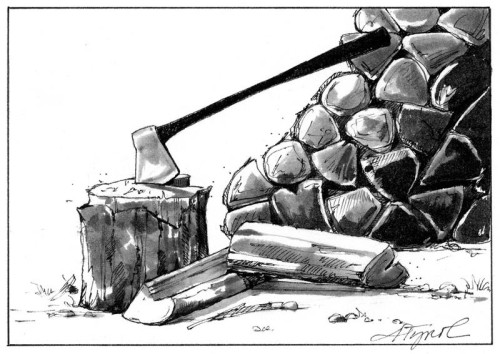
Wild swings in the price of home heating oil and propane have caused many residents of Vermont and New Hampshire to dust off and fire up their old woodstoves. Those who have looked into buying a new stove for parlor, kitchen or basement are discovering something new: wood gasification.
The evolution of wood burning from the outdoor bonfire to today’s high-tech appliance had been gradual until relatively recent years. Innovation number one was the indoor stone fireplace, followed by innovation two, the “Rumford,” a tall, shallow fireplace. Rumfords, which were popular in the first half of the 19th century, reflected more of the fire’s heat into the room than the traditional stone fireplace, but not much more. Neither design addressed the fact that all open fireplaces are typically net energy losers for a house. Fireplaces often suck more of the room’s heat up the chimney than they reflect into the room, especially as the fire dies out.
The third innovation was the airtight woodstove, which enabled the user to completely close off the flow of air to the fire. This prevented warm room air from being lost up the chimney and kept a bed of coals smoldering all night, making it easier to start the next morning’s fire. But those old “airtights” had drawbacks: The coals, barely smoldering in the absence of sufficient oxygen, produced carbon monoxide that could be dangerous and creosote that could build up in the chimney, ignite, and burn the house down.
Innovation number four came during the mid-1970s, when fuel shortages turned many northern New Englanders back to the woodpile. The cutting-edge stoves of that period, required by the Environmental Protection Agency under the Clean Air Act, captured the toxic smoke, mixed it with fresh oxygen, and forced it through a catalytic converter, thereby reducing air pollution and providing more heat that otherwise would have gone up the chimney. Catalytic woodstoves are cleaner and more efficient. They were a major step forward.
But the converters themselves are expensive, tend to clog up, and require replacement, especially if the user activates the converter before the fire is hot enough to ignite the secondary combustion. Plus, activating the converter requires flipping a lever; and while no north country native ever forgets to flip the lever before refilling the stove with wood, visitors from down state are forever smoking up the house and ruining the smell of morning bacon, sizzling on the skillet.
Innovation number five, the state-of-the-art in today’s woodstoves, is the “non-catalytic” woodstove, which achieves the same efficiencies by running the smoke through a series of perforated pipes that introduce fresh air and allow the smoke to “re-burn.” These stoves are cleaner and more efficient and don’t require the use of levers.
But the final innovation, wood gasification, is better still because it directly addresses the chemistry of the problem, namely that efficiency in a woodstove is best achieved with two separate chambers—an insulated one for high-combustion temperatures and a non-insulated one for transferring the resulting heat into the house. Wood is loaded into a firebrick-lined firebox, where it smolders, throwing off smoke. A fan then blows the smoke through a ceramic nozzle, where it mixes with fresh air, re-burns at much higher temperatures, and is forced through a heat exchanger to heat the house. The results are efficiencies that rival new oil- or gas-fired boilers and produce very little smoke.
Gasifying wood boilers (not to be confused with the outdoor boilers that seem to be proliferating these days and are little more than airtight woodstoves) have two disadvantages: They are expensive, just like any whole-house heating system, and they are big, meaning that they live in the basement or in a shed, not in the family room. But if heating eight or ten rooms with one fire is your goal, the gasifying wood boiler is the way to go.
Whether you’re running a new gasifier or an antique potbelly handed down from your great-grandparents, consider these three tips for running your stove safely and efficiently. First, burn only dry wood that’s been under cover for at least a year. Wet wood reduces the temperature of the fire and creates a smokier burn, with lots of heat lost up the chimney in the form of steam. Second, never choke off the airflow altogether. If your goal is an “all nighter,” maintain a deep ash bed that will insulate and preserve a few live coals for the morning. Finally, burn only wood or clean paper. Shoving in whatever comes to hand—coated wrapping paper, cardboard with duct tape, leftover pasta (it’s worse than you might imagine, even al dente)—can gum up your stove and make your house smell like the old town dump, back when outside burning was still legal.

